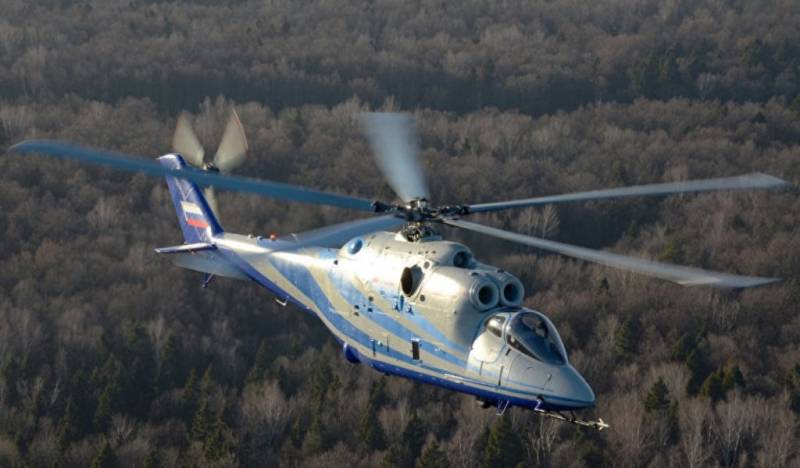High-speed combat helicopter
Recall that last year a research project was launched, so far known as the “High-Speed Combat Helicopter”. As part of this project, it is planned to work out the look of the future combat vehicle, and then implement it in the form of a full-fledged helicopter. The works started in the middle of the year 2017, but already managed to produce some results. Over the past few weeks, the issue of creating a high-speed helicopter has been repeatedly raised by representatives of the Ministry of Defense and Industry.
On February 6, during a visit to the Progress plant (Arsenyev, Primorsky Krai), Deputy Defense Minister Yuri Borisov revealed some details of the new State arms program. In the framework of the State Program 2018-25, a new aviation equipment, including one with special characteristics. Yu. Borisov recalled the desire of the military department to get a promising combat helicopter with a cruising speed of 350-400 km / h. The deputy minister also mentioned that industry has certain technical solutions for such a task.
February 15 news agency Interfax-AVN published excerpts from an interview with Andrei Boginsky, general director of the Russian Helicopters holding company. The head of the organization specified already known data, and also announced new information. According to him, this year the specialists of several helicopter-building organizations are now busy forming the concept of a new high-speed helicopter. The industry leaders represented by Mil and Kamov are involved in this work. In fact, there is a competition between two design schools that prefer different ideas and solutions.
The current work on the formation of the concept of the helicopter is carried out in accordance with the contract concluded during the forum "Army-2017". They are expected to be completed in November 2018. According to the results of the current research work, the Ministry of Defense will be presented with one or several concepts of a promising rotor-wing machine.
The future of a promising project has not yet been determined. Russian Helicopters plan to begin testing a new type of experienced combat vehicle after 2025. In this case, the exact timing of the first flight depends on a lot of factors. Different features of the chosen concept, technical requirements, difficulties, etc. may affect the project.
As follows from the latest news, before the construction of a full-fledged military helicopter, the aviation industry will manufacture and test an experimental model. February 22 TASS news agency published statements by the General Director of Rostec State Corporation Sergey Chemezov. He noted that the industry has some groundwork on high-speed helicopters, and work will continue in this direction next year. Moreover, in the 2019, flight tests of an experimental helicopter built using new ideas can begin. The exact date is not yet indicated, and the beginning of the test may move by the end of next year.
S. Chemezov claims that the speed of a prototype machine designed to work out new ideas will exceed 400 km / h. It should be noted that in this case, the characteristics of the helicopter will be even higher than required by the Ministry of Defense. Whether it will be possible to fulfill such plans will be known later.
February 25 on the TV channel "Star" were announced new details of the future project of a full-fledged combat vehicle. The head of the NRU of onboard radio-electronic equipment and aircraft armament of the Central Research Institute of the Air Forces Pavel Shchavelev told about the intentions to create two versions of a promising helicopter. The first version of the technology will be a regular helicopter, controlled from the cockpit by the crew. The second version of the project will include the construction of an unmanned helicopter. Piloted and unmanned samples will be able to interact with each other and jointly solve the set combat missions.
Despite the large amount of news and statements published in recent weeks, basic information about a promising combat helicopter, or at least its experimental predecessor, is still unknown. The reasons for this are obvious. At present, the main enterprises of the holding company “Helicopters of Russia” are working on concepts, and therefore it is too early to speak about the specific appearance of the new high-speed helicopter. The preliminary elaboration of the appearance of the car is planned to be completed before the end of the next autumn, and, apparently, it is then that the general public will be able to learn the details of the project.
However, certain assumptions about the technical appearance of the future rotary-wing machine were expressed last summer, shortly after the signing of the contract for the work on the “High-Speed Combat Helicopter”. According to Rostec State Corporation, in this project it will be possible to use the promising turboshaft engine VK-2500М, developed by ODK-Klimov. This product will differ from its predecessors more power and reduced weight; It can be used both on high-speed helicopters and on the updated equipment of existing types.
At that time, the VK-2500M project advanced far enough, and its full implementation did not require much time. It was stated that in the case of receiving a real order, ODK-Klimov would be able to complete the design and build a prototype engine within a year. Whether the new VK-2500M will be used on a promising helicopter is unknown. Russian Helicopters have not yet announced their plans for the power plant.
It should be noted that a promising combat helicopter is not created from scratch. So, since the beginning of this decade, several research projects have been carried out, the purpose of which was to study the characteristics of helicopter technology with enhanced flight characteristics. Two research projects were carried out in 2011 and 2013, and since 2014, new work has been carried out, implying the construction and testing of a full-fledged flying laboratory. Curiously, the 2014 project of the year was not funded by the military, but by the Ministry of Industry and Trade. The new helicopter was developed as part of the federal target program “Development of Russian civil aviation technology for 2002 – 2010 years and for the period up to 2015 of the year”.
By the fall of 2014, certain results were obtained, but they were considered unacceptable. It turned out that the helicopter of the future is indeed able to reach speeds of more than 400 km / h, but this requires certain technical solutions, leading to a serious increase in operating costs. For some time the program was stopped.
Soon, research continued. In addition, Russian Helicopters continued to build a new flying laboratory developed on the basis of the combat Mi-24. The experimental model called PSV differed from the serial combat helicopter in the form and design of the fuselage, the new profile of the main rotor blades, modified control systems, etc. The first flight of the prototype took place at the end of the 2015 of the year. For several months, the horizontal flight speed was able to bring to 405 km / h. It was shown that new blades can be used in other projects, giving a noticeable increase in flight characteristics.
A few days ago, the head of Russian Helicopters, A. Boginsky, recalled a pilot project, and also spoke about its impact on other developments. According to him, now an experienced helicopter is being used to test a new carrier system. Also tested transmission, tail rotor and other units. The flying laboratory is actually used to create a groundwork for the development of a future combat helicopter. The design offices involved in the new project take into account the test results of the experienced PSV and use the new data in their work “High-Speed Combat Helicopter”.
Work on civilian and military helicopters with increased flight speeds go in parallel. Apparently, this approach will be maintained for a certain time. Next autumn, Russian Helicopters intend to complete work on the formation of a combat vehicle concept, which will definitely have a certain impact on the further course of projects.
While the program "High-speed combat helicopter" is at the stages of theoretical study using some of the results of previous projects. In the fall, the Ministry of Defense specialists will have to familiarize themselves with the presented variants of the technical appearance of the future combat vehicle, after which its design will start.
According to recently announced plans, next year “Russian Helicopters” can lift a new prototype into the air, designed for testing various technical solutions. A full-fledged high-speed helicopter suitable for use in the military, will appear only after a few years. His tests so far relate to the period after the 2025 year. When the new equipment begins to enter the troops, it remains only to guess. Probably, with the successful implementation of all the required work, the army will receive new helicopters in the early thirties.
According to experts of the military department, in the future, armed forces may need combat helicopters characterized by high airspeed. For a long time, such ideas were taken into work, and were also studied at the level of theory and practice. In the near future, the next real results will be obtained, and in a few years new equipment will enter service.
On the materials of the sites:
http://russianhelicopters.aero/
http://interfax.ru/
http://tass.ru/
https://tvzvezda.ru/
https://iz.ru/
http://arms-expo.ru/


Information